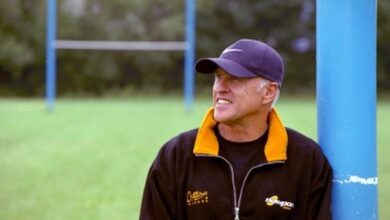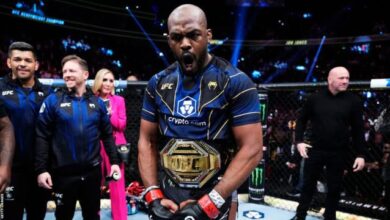THE SUCCESS AND SACRIFICES THAT TOOK KATIE TAYLOR ALL THE WAY TO TOP OF SPORT.
Katie Taylor wasn’t sure about any of this, other than that something needed to change. Something in her life had to be new. Before she became the best pound-for-pound female boxer in the world or the undisputed lightweight champion, she had been a woman in the Dublin, Ireland, airport nervous about what was next.
It was 2016, and Taylor and her mother, Bridget, were about to fly to the United States to meet with a trainer Taylor had long revered from afar but had never met. She’d reached out to him in a Twitter direct message, asking if she could train with him for a few weeks.
Ross Enamait, whose methodologies Taylor had studied and used when she lived in Ireland, agreed to strength-and-conditioning training. They would try each other out and see what happened.
It had already been a tumultuous 2016 for Taylor. Her father and longtime trainer, Peter, had left the family, creating drama that led to a father-daughter boxing breakup, disrupting both Taylor’s personal life and her training regimen. Then the defending gold medalist from the 2012 Olympics suffered a controversial quarterfinal loss to Mira Potkonen in the 2016 Rio de Janeiro Games.
So, as Taylor arrived in the United States, there was exhilaration in the possibility of newness, along with an internal debate over whether or not she would stay an amateur, where she’d won five world championships, or turn professional in a sport where money was sparse and attention limited.
Taylor, a pioneer for women’s amateur boxing in Ireland, will again make history on Saturday, this time as a professional, when she and Amanda Serrano become the first women to headline a boxing card at New York’s Madison Square Garden.
Back in 2016, this seemed unlikely for so many reasons, both for Taylor personally and because of the status of women’s boxing itself. After losses in the world championships and Olympics, Taylor was feeling conflicted about the sport she had dedicated her life to, the sport she had left the Irish national soccer team for in 2009 to pursue full-time. She just knew alterations were necessary, leading her to a small town in a foreign country and an unclear future.
“There’s a risk in any decision you make, but that’s part of life,” Taylor said. “You have to take those big risks, and I loved the challenge of what I was about to do. And that was bringing women’s boxing up to a certain level and just seeing what the perception was of women’s boxing and trying to change. And I love that challenge.
“I think I always wanted to be a trailblazer in my sport, even in the amateur days. And trying to do something big in the pro game was super exciting to me.”
Before the past half-decade, in which Taylor became an even bigger star in Ireland and helped guide an entire sport through the beginnings of a growth process, she first had to decide if she even wanted to try. She got off the plane and drove to Manchester, Connecticut, just east of Hartford, and started training with Enamait while staying with her mother at a Days Inn.
After a couple of weeks, Taylor knew she had made the right decision. She had a path in boxing again, an understanding of where she wanted to go in the sport. She returned to Ireland and reached out to promoter Eddie Hearn through direct message. For someone who doesn’t like social media much, there’s irony in two of the biggest decisions in Taylor’s life essentially starting through social media messaging. She asked Hearn if he was willing to talk with her about going pro.
Hearn was curious but skeptical. He met with Taylor because he knew her name from the amateurs, but now acknowledges, “I wasn’t confident that this would have a big future.”
When they met, Taylor pitched both herself and women’s boxing in general. She explained how she had helped get women’s boxing into the Olympics as an amateur and how she wanted to grow the sport and herself as a professional. Ten minutes in, Hearn wanted to get involved.
Taylor turned pro. She moved her training camps from Ireland to Connecticut. For her own happiness, her own future, it was the only decision to make. She knew the negative ramifications — some amateur sponsors from Ireland dropped her when she turned pro and moved continents.
“I really didn’t care about any of that stuff,” Taylor said. “Because I got my love for the sport back and I felt like I was learning so much being around Ross. And that, to me, was everything. At the time, I felt like my boxing was going downhill and I wasn’t really enjoying the sport.
“It was a struggle for me getting up out of bed to even go to the gym at times and I hated that, because I always genuinely loved my sport and loved boxing. So grateful to be involved in something that I actually love doing. And once I came over here, just learning new things again, learning about the pro game, I actually loved that.”
At first, the move was going to be for only a few weeks. Then it was for a training camp. She bounced back and forth between her hometown of Bray, Ireland, and Manchester, living in hotels while in Connecticut and having her mom visit occasionally.
The constant bouncing between continents wasn’t good. The travel. The cost. She spent more time in America than Ireland anyway. And if she wanted, she could always fly back home. So Taylor made another big decision: She decided to move to the United States.
WHEN TAYLOR FIRST arrived in the United States, she knew no one. She met a few people while training, but she felt uprooted.
Taylor had never been on her own. Never lived away from the bubble of her family during her first three decades of life. Her father had been her trainer. Her mother had always taken care of almost everything else, including laundry and cooking. Her brother and sister, both close friends, had provided emotional support. But now a family already adjusting to having portions of its private life being made public was having a more difficult conversation: Taylor would be leaving, too.
“It was, genuinely, a difficult decision,” Bridget Taylor said. “A difficult time for her because just the fact that you’re kind of leaving everything, you know, everyone you know. Simple things, like even learning to drive on the other side of the road.”
Taylor moved for boxing. That was familiar. Everything outside of boxing was jarring. Bray is a seaside town south of Dublin. Vernon, where she lives, and Manchester, where she trains, are in the Connecticut countryside, landlocked and 34 miles from the beach.
An intensely private person, Taylor needed to put herself out there in order to create a life for herself in an unknown place. Enamait helped her find an apartment, but Taylor admits life in the United States “was quite tough.” Not having people near her was difficult, even with FaceTime. She learned to do her own laundry, cook for herself and make new friends in a foreign place.
So Taylor leaned on what she always knew. She had boxing — her training — and her Christian faith. She began scouting churches the same way one looks for houses or schools.
“I went church-hopping for the first few months,” Taylor said. “Just trying to find the right church for me, really.”
She eventually found one in Vernon — she declined to say which one because she doesn’t want people coming to try to find her — and within it discovered her new community. She realized something else, something she hadn’t experienced for years in Ireland, where she was a celebrated star.
No one in the United States knew who she was. She had anonymity and could buy groceries unbothered. Her new friends supported her boxing when they eventually found out about it, but weren’t in awe of it.
Coming to Connecticut was a move her family isn’t sure she had to make. But looking back, they understand how it changed the 35-year-old Katie Taylor in so many ways beyond boxing.
“She had to learn how to discern people’s motivations. She had to learn how to make those relational decisions for herself,” her brother, Peter, said. “So there’s a whole plethora of things that were really good about that move.
“But emotionally, you know, it doesn’t change the fact that it was one of the most difficult things that we’ve had to do as a family.”
Taylor said if her father hadn’t left, she probably wouldn’t have departed her protective cocoon in Ireland. Taylor’s brother even wonders if she would have turned professional had her father still been her trainer, which would have meant a completely different past half-decade for Taylor — and the sport she thrives in. But sometimes the pain of the present can lead to a prosperous future.
“It was really, really heartbreaking,” Taylor said. “But I feel like I wouldn’t have made those big decisions if it wasn’t for that time, and I think it’s worked out the best for me, for sure.”
Taylor said she has a great relationship with her father now. But the decisions made back in 2016 had far-reaching consequences and forced Taylor to live differently while remaining fundamentally the same person she was before.
THE WHITE, WEATHERED sign hangs above the heavy double doors of this red brick building on a side road in Manchester. “Ring of Champions Society” is written in black with gold trim, two red boxing gloves underneath with “EST. 2011” written in black and “Manchester” in blue script.
From the main road, it looks like any other building, not a boxing gym where the best female fighter in the world trains. Yet the gym undeniably fits Taylor. Next to a church called, of all things, St. Bridget’s. On Chapel Street. Understated, anonymous, unless you know what you’re looking for.
Inside, there are photos of fighter after fighter who has trained here. Fight posters of the bigger names to come out of the gym, including the undefeated junior welterweight Mykquan Williams, and newspaper clippings celebrating their accomplishments.
Except for one. Taylor.
Unless you actually saw her in the gym, you would have no idea she trains here. That she moved from across the ocean, in part, to become a champion here. This doesn’t bother her. She smiles at the realization of it.
It’s part of the anonymity she loves and the privacy she seeks. In a documentary about Taylor’s life, Hearn said he isn’t sure if he knows who Katie Taylor really is. He knows her, but he doesn’t truly know her. Taylor has never been inclined to let people in, except her close circle of family and friends.
“It’s really difficult,” Hearn said, “to get to know Katie Taylor.”
Over the years, that has softened. Taylor has shown more than the singular focus on boxing she portrays to the world. She has allowed her dry sense of humor to show, the one she allowed her new friends from church to see. A more vulnerable side has been revealed in meals and conversations over the years as she has settled into her new home in Vernon.
She likes her life in Connecticut with the occasional holiday visit back to Ireland. Taylor bought a house that is, unsurprisingly, in a small neighborhood surrounded by woods.
“I just love the quietness, really,” Taylor said. “Especially when you’re in the thick of training and I don’t need any loud neighbors or anything like that. For training camp, that type of house is definitely perfect.”
It gives her peace and allows her to continue to have the anonymity she loves. Her life is simple: Boxing, church and, lately, “Seinfeld” on Netflix.
Her brother, Peter, got hooked on it when he was a space sciences fellow at Cornell University, and he turned his sister on to the world of Jerry, Elaine, George and Kramer. Growing up in Ireland, she’d never seen the show. But it became the perfect training camp diversion.
She can’t relate to the characters “because they all seem to have different girlfriends or boyfriends in every single episode. It’s like, ‘Is that how people live?'” But she laughs hard at each episode and lately has found David Puddy, the character played by Patrick Warburton, to be particularly hilarious in “The Burning.”
“The sense of humor was actually brilliant,” Taylor said. “There are so many one-liners in each episode, it’s just fantastic.”
Beyond boxing and her comic diversions, Taylor is also devoted to her principles. Her manager, Brian Peters, said she has routinely turned down endorsements if she didn’t feel they were the right fit for her or the message she was trying to send to younger people. One such deal, Peters said, was “mid six figures.” This happened early in her career, too, when she was not making much per fight.
“I’ve worked with a lot of athletes, but as I say sometimes, we all have a price, whether we like to think it or not,” Peters said. “So what I can say is, Katie Taylor has no price.
“And that’s the first human being I’ve met like that.”
Life is about something else for Taylor. It’s about legacy and creating something that will last longer than her decorated career.
TAYLOR IS IN Ring of Champions on a Monday morning in February. It’s just her and Enamait — Taylor in a black sweat jacket and gray pants — starting to work. The music in the background ranges from Flo Rida’s “My House” to Katy Perry’s “Roar” to Warren G’s “Regulate.” The only other sounds in the gym are the grunts and the leathery thwap of glove hitting mitt.
She’s focused on this day of shadowboxing, mitt work and abs work that would make the average person hurt. She works out for an hour at this gym in the small town she considers part of her home, training for a fight she has wanted since she chose to turn pro.
This weekend in New York, she fights Serrano, a seven-division world champion who will be Taylor’s most difficult opponent. It’s a fight that will land Serrano and Taylor seven-figure paydays as headliners at Madison Square Garden, one of the most iconic venues in sports and entertainment. It’s the biggest fight in women’s boxing history on the biggest stage of the sport.
So of course it will include Taylor, who has been the leader of the modern era of women’s boxing. Taylor is the one who helped land women’s boxing in the Olympics by fighting showcase amateur bouts in front of the International Olympic Committee in order to promote the sport. She’s the one who went to Hearn and convinced him to take her on. Hearn said if not for Taylor, he wouldn’t have pushed women’s boxing as he has — he’s now one of the most prolific promoters of women in the sport.
Taylor’s success helped broadcasters buy into women’s boxing and its growth. It showed other amateurs a path to being a professional. She also pushed Hearn for larger purses for herself and other women through her own stubbornness. Hearn said they renegotiated Taylor’s contract four times to adjust for the value Taylor brought to the sport and Hearn’s promotion.
“The numbers that she was making, when she turned pro, were ridiculous compared to her value now,” Hearn said. “And that just shows you the growth, the way that we’ve kept having to change her purses. And she’s made a lot of money.”
The money helps — there’s no question — and fighters from Taylor to Serrano to Claressa Shields and Mikaela Mayer have all talked about equality in boxing. It’s Taylor who helped it all get to this point.
Taylor has helped inspire generations to come. When she started as an amateur, she was the only woman in the boxing gym. She pushed to have women’s boxing legalized in Ireland. She helped get the sport into the Olympics. Then she changed her entire life and helped to elevate the presence of women’s boxing as a professional. Now she goes to gyms back in Ireland that are full of girls trying to be the next her.
It all has led here, to the biggest fight she has ever been a part of, one that’ll be part of her memory forever.
“This is just history for me. I’ve always wanted to be a history maker in my sport, and I just feel like all the sacrifices that I have made over the years is worth it for just this one moment alone,” Taylor said. “It’s not just for me or for Amanda, it’s for the next generation of fighters coming up.
“I think we’re pushing back the boundaries again and we’re making the path an awful lot easier for the next generation. And that, to me, is everything”.




